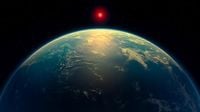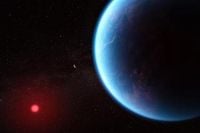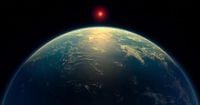On April 17, 2025, scientists using NASA's James Webb Space Telescope (JWST) detected what they describe as the "most promising" evidence yet for alien life, with chemical fingerprints of life found on the exoplanet K2-18b, located 124 light-years from Earth. The discovery of the molecules dimethyl sulfide (DMS) and dimethyl disulfide (DMDS) in the atmosphere of K2-18b has sparked excitement and skepticism within the scientific community.
K2-18b is a significant find in the search for extraterrestrial life; it is 2.6 times the size of Earth and 8.6 times its mass, and is suspected to be a "hycean world"—a type of exoplanet with a vast ocean and a hydrogen-rich atmosphere. This classification suggests that K2-18b could host conditions suitable for life, as it orbits its star in the habitable zone, where liquid water can exist.
The detection of DMS and DMDS is particularly intriguing because, on Earth, these molecules are primarily produced by life forms such as marine algae and microbes. In prior research published in 2023, the same team of researchers detected methane (CH₄) and carbon dioxide (CO₂) in K2-18b's atmosphere, marking a significant milestone in the search for biosignatures beyond our planet.
In the latest study, the researchers utilized JWST's Mid-InfraRed Instrument (MIRI) to analyze the planet's atmosphere, revealing specific spectral features that can only be explained by the presence of DMS or DMDS. "The signal came through strong and clear," said Nikku Madhusudhan, a professor of astrophysics at the University of Cambridge and lead author of both studies. The concentrations of DMS and/or DMDS detected may be as high as 10 parts per million by volume, significantly greater than the levels found on Earth, which are below one part per billion.
However, the findings have not been universally accepted. Some scientists express skepticism regarding the evidence. Tessa Fisher, an astrobiologist at the University of Arizona, remarked, "It’s almost certainly not life," while Stephen Schmidt from Johns Hopkins University suggested that the evidence is not strong enough to draw definitive conclusions. Critics argue that the detection may be a result of statistical fluctuations rather than a genuine biosignature.
The researchers acknowledge the need for caution. "It’s important that we’re deeply skeptical of our own results, because it’s only by testing and testing again that we will be able to reach the point where we’re confident in them," Madhusudhan stated. To strengthen their case, the team plans to conduct further observations to achieve a five-sigma significance level, which is the standard for confirming scientific discoveries.
Despite the skepticism, the implications of the discovery are enormous. If the findings are confirmed, they could represent a groundbreaking moment in our understanding of life beyond Earth. DMS and DMDS are not known to be produced in large quantities through non-biological processes on Earth, making their detection on K2-18b a significant indicator for the potential presence of life.
Moreover, the study of K2-18b contributes to a broader understanding of exoplanets, particularly those classified as mini Neptunes, which are some of the most common types of planets identified in our galaxy. Researchers like Madhusudhan believe that such planets could be prime candidates in the search for extraterrestrial life.
In a previous study, the same team had hinted at the presence of DMS but could not confirm it due to low statistical significance. The new measurements, however, provide stronger evidence. "We didn’t know for sure whether the signal we saw last time was due to DMS, but just the hint of it was exciting enough for us to have another look with JWST using a different instrument," Madhusudhan explained.
The debate surrounding K2-18b and its potential to host life is ongoing. Some researchers argue that the planet may not have the necessary conditions to support life, suggesting that it could be barren. Joshua Krissansen-Totton, a planetary scientist at the University of Washington, stated, "A lifeless mini-Neptune scenario remains the most parsimonious explanation."
As scientists continue to analyze the data, they remain hopeful that future observations will provide more clarity on the existence of DMS and DMDS in K2-18b's atmosphere. The potential for discovering life beyond Earth has captivated humanity for centuries, and with advancements in technology, astronomers are now closer than ever to answering this age-old question.
In summary, the findings from the JWST regarding K2-18b represent a significant step forward in the search for extraterrestrial life. While the evidence is still being scrutinized and debated, the possibility of life on this distant exoplanet remains a tantalizing prospect. As researchers continue to explore the cosmos, the search for signs of life will undoubtedly remain a focal point of scientific inquiry.




